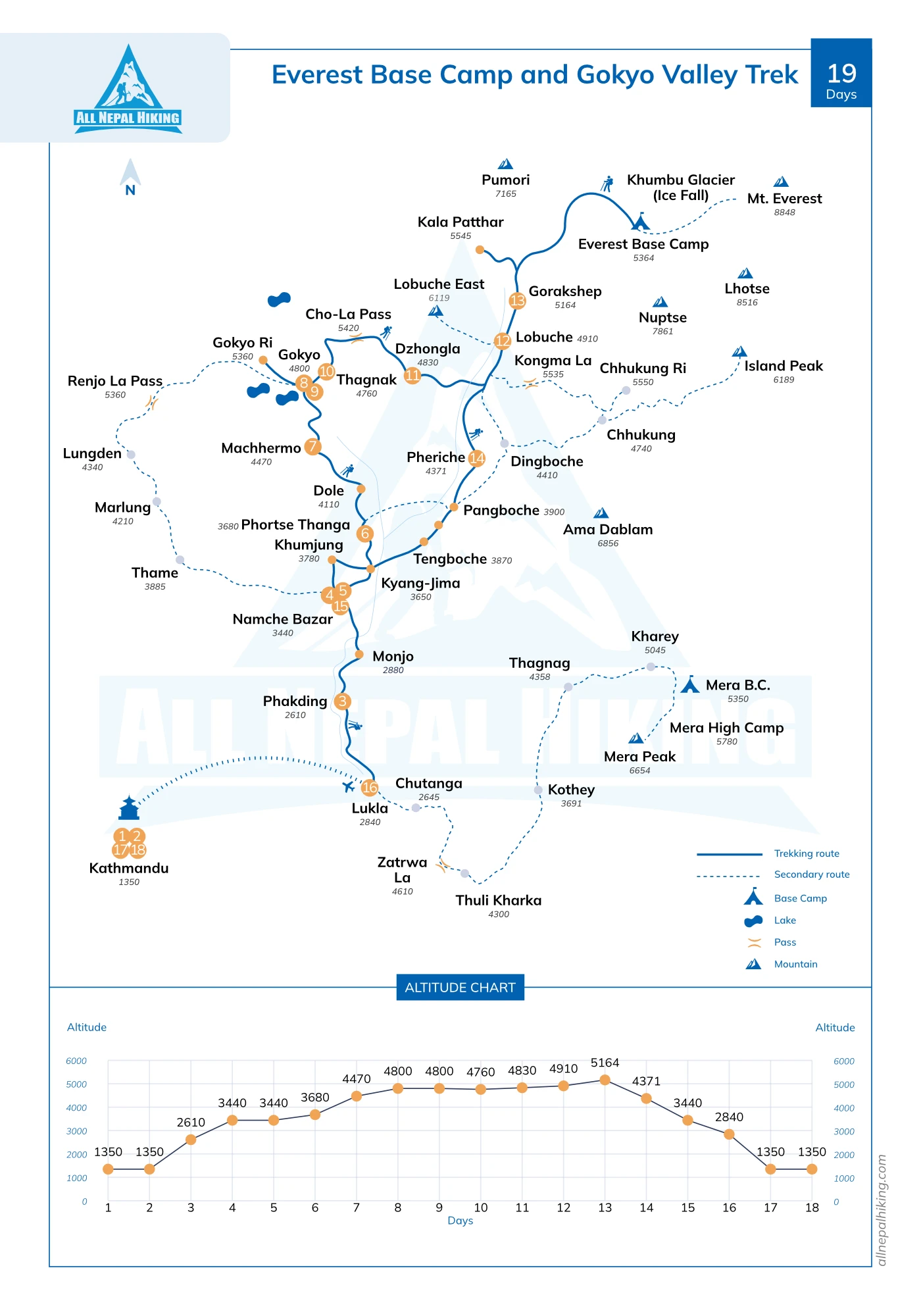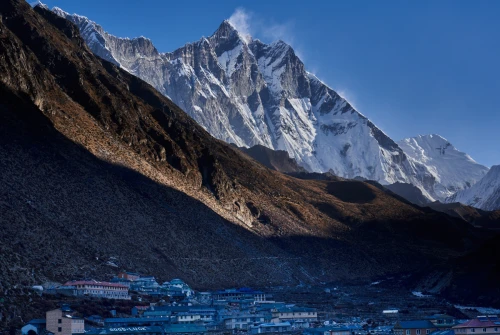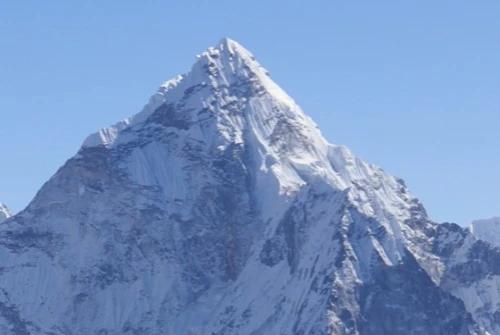The Gokyo Lake and Everest Base Camp Trek, also known as the Everest Circuit Trek, is a challenging and adventurous journey in the Everest Himalayas. It covers the route from Gokyo to the Everest Base Camp, passing through the high pass of Cho La (5330m). Along the way, trekkers can enjoy breathtaking views of Mount Everest (8848.86m) and other peaks in the Khumbu region. The trek also offers a chance to explore Buddhist monasteries located at high altitudes.
This 19-day trek starts from Lukla and follows the Dudh Khosi Valley to reach Namche Bazaar, a popular hub for trekkers in the Khumbu region. The trail leads through beautiful forests of rhododendron, magnolia, and fir trees, leading to the stunning Gokyo Lakes and Gokyo Valley. The hospitality of the locals adds to the overall experience, making trekkers feel at home. As the journey progresses to higher altitudes, the natural beauty of the snow-capped mountains and mesmerizing sunsets and sunrises leave a lasting impression.
The trek continues to Gorakshep and finally reaches the Everest Base Camp, followed by a visit to Kala Patthar. The sight of the majestic Himalayas in the Khumbu region is awe-inspiring and captures the hearts of trekkers. The Gokyo and Everest Base Camp Trek offer an unforgettable experience, more than just reaching the destinations; it's about embracing the entire journey.
In comparison, the Everest Base Camp Trek allows exploration of the classic route to the Everest Base Camp, providing natural spectacles, cultural heritage, and insights into the local lifestyle. With the guidance of a trekking guide, trekkers can interact with the locals and learn about the fascinating stories related to Mount Everest and the Everest Base Camp. The Ultimate Everest Trek combines the goodness of both the Everest Base Camp and Gokyo Lake treks, offering an even more enriching experience.
Combining the Mount Everest Base Camp Trek with the Gokyo Lake Trek
Combining the Mount Everest Base Camp Trek with the Gokyo Lake Trek results in the Ultimate Everest Trek, a 19-day journey where actual trekking takes 15 days, and the rest is spent acclimatizing and exploring side treks. The route covers places like Khunde, Dole, Machhermo, and Dragnak, and includes crossing the high-altitude mountain pass, Cho La, at 5420m elevation.
The Gokyo Lake Trek is a separate adventure in the Everest region that introduces trekkers to the stunning attractions of Gokyo Lake, Gokyo Village, and Gokyo Ri. In the Ultimate Everest Trek, you get the chance to experience the best of both treks. Gokyo Valley offers a mix of easy and challenging destinations, allowing trekkers to tailor the journey according to their interests and expertise.
Gokyo Ri, also known as Gokyo Peak, is a mini mountain standing at 5340m. It offers incredible panoramic views of the Everest Region. Though part of the side trek, trekkers can choose to include or skip this hike based on their preferences. The Gokyo Lakes are another highlight of the Gokyo Valley Trek, forming a complex of 19 oligotrophic lakes, displaying a mesmerizing natural blue color amid the grey landscape.
In summary, combining the Everest Base Camp Trek and the Gokyo Lake Trek creates an extraordinary adventure known as the Ultimate Everest Trek, offering a diverse range of experiences and breathtaking views in the Everest region.
How Challenging Is Everest Base Camp & Gokyo Valley Trek?
The Everest Base Camp and Gokyo Valley Trek, also known as the Ultimate Everest Trek, is considered a challenging trek that requires a good level of physical fitness and mental preparation. The trek involves walking at high altitudes, where the air is thinner, making it more strenuous compared to lower altitudes.
Here are some factors that contribute to the difficulty of the trek:
High Altitude: The trek takes you to altitudes above 5000 meters (16,400 feet). At these heights, the air has less oxygen, making breathing more difficult. Altitude sickness is a real concern and can affect trekkers if they ascend too quickly without proper acclimatization.
Long Duration: The trek is about 19 days long, with around 15 days of actual walking. The extended duration can be tiring, and trekkers need to be prepared for long days of walking, often for several hours a day.
Unpredictable Weather: The weather in the Everest region can be unpredictable, with sudden changes in temperature and weather conditions. Trekkers must be prepared for varying weather, including cold temperatures and potential snowfall.
Remote and Basic Facilities: The trek takes you through remote areas with basic facilities. Accommodations and food may not be as comfortable as in urban areas, and amenities can be limited.
Challenging Terrain: The trail includes steep ascents, descents, and rocky paths. Trekkers may encounter suspension bridges and moraines, adding to the physical challenges.
River Crossings: The trek includes crossing several rivers and streams, which can be challenging, especially during the monsoon season when water levels are higher.
While the Everest Base Camp and Gokyo Valley Trek is challenging, it is also incredibly rewarding. The breathtaking views, cultural experiences, and the sense of accomplishment upon reaching Everest Base Camp and Gokyo Ri make it a trek of a lifetime. Proper physical training, acclimatization, and preparation are essential for a safe and enjoyable experience. It is recommended to trek with an experienced guide or in a guided group to ensure safety and support throughout the journey.
Importance Of Everest Base Camp and Gokyo Valley Trek Trek Map
Having a map of the Everest Base Camp trek or the Gokyo Lakes trek can be incredibly valuable during your journey, and it becomes even more essential if you're embarking on the Ultimate Everest trek, which combines both routes. You can purchase separate maps for each trek or find a comprehensive map that includes details about both routes. Having a map gives you a sense of independence and provides crucial information about the route before you start the trek. With a map in hand, you can confidently explore the trails, and it's especially useful for solo trekkers. Having a map is a wise decision and adds to the overall safety and enjoyment of your trek.
Ideal Time To Trek Everest Base Camp and Gokyo Valley Trek
The most ideal time to embark on the Everest Base Camp trek is from September to November. During this period, the weather conditions are generally pleasant, with moderate temperatures that are neither too hot nor too cold. The skies are clear and visibility is excellent, providing trekkers with breathtaking views of the surrounding mountains. The post-monsoon season ensures that the trails are relatively dry and more accessible. However, it's important to note that this is also the peak trekking season, so the routes can be quite crowded with fellow trekkers. If you enjoy the company of other travelers and wish to experience the vibrant atmosphere of the trekking community, this is an excellent time to go.
Another favorable time to consider for the Everest Base Camp trek is from April to June. During these months, the weather is relatively mild and pleasant, although it can be slightly warmer compared to the autumn months. The advantage of trekking during this period is the lower number of tourists on the trails, allowing for a more peaceful and solitary experience. However, the trade-off for this tranquility is that the visibility might not be as clear as during the autumn season. The skies can be hazier, affecting the panoramic views of the majestic Himalayan peaks.
Both of these trekking seasons have their unique advantages, and the choice ultimately depends on your preferences and priorities. If you prefer favorable weather and stunning mountain views but don't mind a bit of crowding, the September to November period would be perfect. On the other hand, if you prioritize a quieter and more tranquil trekking experience and can compromise a bit on the visibility of the mountains, then April to June could be the best time for you to undertake the Everest Base Camp trek. Regardless of the season, proper preparation and a sense of adventure are essential for making this iconic trek a memorable and rewarding experience.
All Nepal Hiking has a proven track record of successfully organizing treks across Nepal, and we are proud of the positive reviews received from our previous clients. We offer highly knowledgeable and experienced guides to ensure that your trek is enjoyable and memorable. Our services cater to both experienced trekkers and those new to trekking, with equal dedication. If you are planning to trek in Nepal, we welcome you to join us for an unforgettable holiday experience in this beautiful country.



 based on 9 reviews
based on 9 reviews
